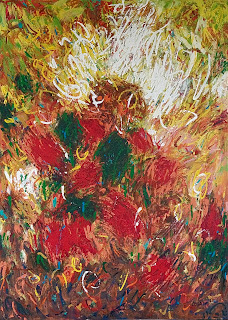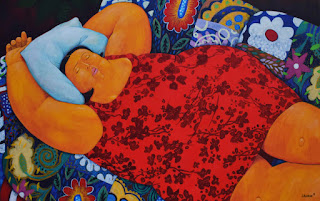Saturday, July 15, 2023
Historical Distortion
Diving into Legaspi's Historical Distortion
by Kaye O'Yek
In Historical Distortion, Silaynon artist Raymond Legaspi interweaves chronicled national events, art masters' famous works, and paintings he is particularly fond of into his abstract creations. His deep appreciation for Filipino history fuels this exploration, infusing his works with the spirit of the past as he carefully selects significant events that have shaped the nation's identity. In turn, he confronts and remakes them through his unique lens. The artist reimagines these historical narratives, infusing them with a fresh and contemporary perspective. By translating the figurative into vibrant abstractions, he blurs the lines between reality and imagination, challenging viewers to reconsider their perceptions. By distorting traditional depictions of historical figures and events, the artist invites viewers to engage in a dialogue that transcends the boundaries of time and space.
Historical distortion is an academically documented phenomenon associated with an infamous dictatorial family name. In a CNN interview in the wake of the latest Philippine national elections, notable historian Ambeth Ocampo explained that revisionism is "not the correct term, simply because when we revise, we reflect—we correct. Revision is meant to go towards truth—to do something correctly. So if you do otherwise, it's actually distortion or denialism, so it should rightfully be called historical distortion."
Legaspi's artistic journey is a vibrant exploration of the figurative, translated into captivating abstractions that pulsate with energy. Each canvas is a testament to the artist's uninhibited expression, employing a potent interplay of lines, scumbles, and active applications of paint. He creates a tapestry of tints, tones and textures that evoke a sense of dynamism and movement that may also be found in his past works featuring abundantly luscious figures set In fantastic backgrounds, whether on land or underwater. With his full-time artistic practice beginning in 2006, it seems the artist rarely touches on political themes. For this collection of recent works, however, whose conceptualization has percolated since the pandemic, he unleashes his unique, unfettered abstract expressions, utilizing the artist's way to confront and control the narratives entangled in distortionism head on.
September 21, 1972 is inspired by a significant turning point in Philippine history that delves into the depths of emotion and uncertainty. The painting encapsulates the tumultuous atmosphere and the artist's interpretation of the events surrounding the declaration of Martial Law, offering a visceral and thought-provoking exploration through his expressive linework and emotive use of color, specifically those associated with TV sign offs. The artist captures the turmoil and unease that marked this pivotal event, inviting viewers to reflect on its enduring impact. The Bloody Golden Years in frantic yellow, white, and black with spatters of red and cyan echoes the force of pouncing bellows perched upon a spreading pool of crimson. Authorities might have been quick to cover up the brutality, but with the help of media documentation and contemporary art, it will not be forgotten. Imelda's Picasso explores the complex relationship between art and power. Drawing inspiration from a famously sought-after masterpiece that magically transformed into a humble poster, the artist unleashes his own instinctual interpretation, revealing the intertwining of influence, artistry, and historical distortion.
Legaspi's reverence for art masters and national artists is evident throughout this exhibition. With each piece, he pays homage to their contributions while infusing his own personal touch. The abstract interpretations serve as a visual conversation between him and his predecessors, reflecting the artist's deep appreciation for their influence and his desire to push the boundaries of artistic expression. Direct, instinctual, and highly vigorous, his current technique involves the spontaneous application of vigorous lines and the chance effects of layering.
Abstract art is art that does not attempt to represent an accurate depiction of a visual reality but instead uses shapes, colors, forms, and gestural marks to achieve its effect. Depicting forms not found in the natural world, they emphasize freedom in technique, execution, and emotional expression. In his other works in the collection, Legaspi masterfully transforms recognizable subjects into lively abstractions.
A bold reinterpretation of Juan Luna's monumental masterpiece in Juan Luna’s Spoliarium brings Legaspi's energetic yet conscientious application of paint as the artist delves into the emotional depths of Luna's iconic triumph, bringing a fresh and visceral perspective to the monumental masterpiece. Its emotional intensity and rawness contrast with Juan Luna's La Bulaqueña, which he treats with the airiness associated with the baro't saya's piña weaves.
With his signature expressive style, the artist distorts the traditional representation of the La Bulaqueña, breathing new life into the subject, inviting viewers to engage with the rich cultural heritage she represents, and even adding a fashion accessory that might shield the sitter from too much summer sun. A Family Portrait by Simon Flores captures the dynamics of familial bonds and the interconnectedness of generations through shared experiences and stories. Light and warm pigments dance across the canvas, revealing the artist's instinctual interpretation of family and togetherness.
Amorsolo's Harvest pulsates with a sense of abundance and vitality as the artist translates the idyllic landscapes and bountiful harvests of Amorsolo's iconic scenes into a captivating abstract composition of Filipino rural life, infusing it with his own imaginative touch. In Amorsolo's Little Girl by the Shade, he captures the ethereal beauty and grace of Amorsolo's subject while adding his own interpretive twist in merry reds and greens. Bathers by Victor Edades is dominated by the warm glow of flesh under a relentless sun, while in Collaboration by Edades, Galo, Ocampo and Botong Francisco, Legaspi carefully makes an effort to approximate the hues in the maestros' interactive painting, a prime example of a visual symphony of form and individual techniques embraced by the spirit of collaboration. Lapu Lapu by Botong Francisco is his perception of the portrait of the legendary Filipino hero through an abstract lens, focusing on the courage and strength of Lapu-Lapu while maintaining reverence for Carlos "Botong Francisco's ability to depict the nation's historical figures with grandeur and adoration. He features Feeding Chickens by Anita Magsaysay Ho, paying homage to Ho's celebration of Filipino culture with fondness and faithfulness to the grace of the women portrayed with a sense of rural simplicity and everyday life.
Legaspi also draws inspiration from his favorite Ang Kiukok pieces in Clown by Ang Kiukok and Ang Kiukok Crucifixion. The artist explores the enigmatic and emotive qualities of Ang Kiukok's art through rich reds and crimsons, one featuring harlequinesque shapes floating on canvas and the other gushing out a torrent of emotions, merging anguish and spirituality into a captivating composition that challenges traditional representations. In The Boxer Codex, The Five Peso Independence Day, and the two-faced Laguna Copperplate in night and day, he reinterprets cultural iconography his way: blurring the details while immersing. himself in the feel of these objects and eventually releasing cacophonic glee that may be likened to the discordant ring of nonmusical metallic objects striking together yet melding visually into a glorious and uncanny whole.
Historical Distortion is a generous invitation to view and embrace the transmuting power of abstraction while offering an openness that audiences can fill in with their own experiences. Legaspi's artworks are brimming with life, each canvas beating with the artist's creative energy and the spirit of the masters who have gone before him. With every stroke, the artist captures the essence of the subject matter, inviting viewers to engage with the emotions and narratives embedded within. One simply has to immerse themselves in the vivid and energetic world he has created with bold lines, intricate scumbles, and active applications of pigment on canvas. Through his instinctual approach, undeniably honed by decades of artistic discipline, Legaspi creates a visual language that is both expressive and thought-provoking, imbuing points of history with a fresh and contemporary feel. The artist bears full agency only of himself, not the past, and he uses this creative power to the fullest.
September 21 of 1972 / 122 x 152.5 cm / Acrylic on canvas / 2023
Bloody Golden Years / 122 x 152.5 cm / Acrylic on canvas / 2023
Imelda's Picasso / 117.5 x 80 cm / Acrylic on canvas / 2023
Night and Day (inspired by the Laguna Copperplate of the year 900 AD)
114 L x 30 W x 15 H cm / Acrylic on epoxy / 2023
(back)
Collaboration by Edades, Galo, Ocampo and Botong Francisco / 60.9 x 60.9 cm / Acrylic on canvas / 2023


















.jpg)
.jpg)





.jpg)



























